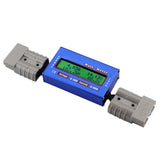How much solar power do you need?
So you want to set your rig up for Solar but you are not sure what size of set up you need? This blog is designed to give you the tools to be able to work out exactly what are you are drawing from your rig's batteries and what type of Solar set up you need. Knowledge is key when setting up your rig for Solar so the more information you have on each and every one of those home comforts devices you plan to take away with you the better. If anyone has a question pop it in the comment section below. I will answer each and everyone.
How to work out Watts, Amps and Volts
It stands to reason that a larger Solar Panel will collect more energy in less time, but just how big does the solar panel need to be?
The power consumption of appliances is given in Watts. To calculate the energy you will use over time, just multiply the power consumption by the hours of use. For example:
10 watt device used over 3 hours equals 10 x 3 = 30 Watt
How to convert Amps to Watts
The energy in Watts is equal to the electric charge in Amps times the voltage in volts:
Watts = Amps × Volts
Example
If your device doesn’t have the Watts labelled on it, then it should at least have the input Volts i.e. 240V and the Amps AC it draws such as 240V – 1.5A. You can then use the equation Watts Volts x Amps so 240v x 1.5amps = 360 Watts.
How to convert Watts to Amps
The electric charge in Amps is equal to the energy in Watts divided by the voltage in volts (V):
Amps = Watts / Volts
Example
Find the electric charge in Amps when the energy consumption is 300 watts and the voltage is 240 volts.
300 Watts / 240 volts = 1.25 Amps
Check out the iTechworld inline Watt meter which does all these calculations for you
HERE
Do I need a battery?
Solar panels are commonly used to charge a battery – not to charge a device directly. There are a couple of reasons for having batteries. Solar panels might not generate enough wattage to directly power an appliance, but they can build up a higher wattage via a battery. Secondly a battery can regulate the power going in to the appliance at a constant rate. When solar panels are charging a battery it is usually at a varying rate which could harm an appliance if not regulated.
Battery capacity is measured in Amp Hours (e.g. 100Ah). You need to convert this to Watt Hours by multiplying the Ah figure by the battery voltage (e.g. 12V) – see calculations above.
AH refers to amp hours. This rating is usually found on deep cycle batteries. If a battery is rated at 100 amp hours it should deliver 5 amps of power for 20 hours or 20 amps of power for 5 hours.
When choosing a deep cycle battery, keep in mind the equipment you will be powering and the time in which they will be running. Theoretically a 100Ah battery can deliver 5 amps over a 20 hour period (and so on). Taking into account the average small campsite - with a small 45W fridge running for 6 hours, 3 hours of 15W lighting and 20W of other electronic equipment - the minimum consumption to be expected is 335W. Take this wattage and divide it by the voltage, 12V, gives 28Ah. With the aim of leaving 50% in the battery brings the requirement to 56 Ah per day.
Check out the only the battery that iTechworld recommends with Solar Power
HERE
What size solar panel do I need?
Solar Panels power generation is commonly given in Watts e.g. 120 Watts. To calculate the energy it can supply the battery with, divide the Watts by the Voltage of the Solar Panel.
120 Watts / 18v = 6.6 Amps
Please note that Solar Panels are not 12v, I repeat Solar Panels are not 12v. Any one who works out the Amps of a solar panels using 12v as the voltage calculation does not understand solar or has been misinformed. All solar panel voltages should be marked in the item description of our website or on the unit itself.
Check out the iTechworld Solar Panel range
HERE
Inverters
The power inverter converts your storage battery power into the 240 volts AC that runs your appliances. Unless you only run 12 volt DC appliances you will need a power inverter to supply your AC.
There are 2 types of Inverters
Pure sine wave and Modified sine wave.
The Pure Sine Wave matches the power to that of which you get from your Electricity Supplier, its clean and you can run any appliances safely even sensitive equipment.
The Modified sine wave used to be considered a dirty power but some aren't as bad as they used to be, you can use this inverter type for things that don't have sensitive electronics for example fridges, cookers, pumps, You may have to be careful with some appliances such as laptops and TVs so check first
Source : Internet/ iTech
More info: Visit Game Store Jabi Lake Mall Ola 08032105060



















